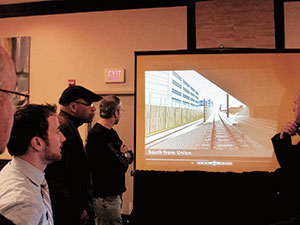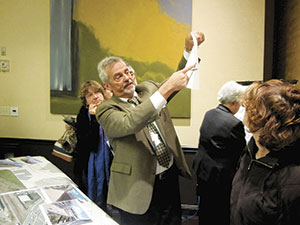
Attendees at the Green Line Extension meeting at the Holiday Inn last week viewed a 3D presentation depicting the Green Line route from Lechmere to Union Square stations. – Photos by Douglas Yu
By Douglas Yu
Residents who attended the first Green Line extension project meeting this year are the lucky ones because they are the first “passengers” in the world to take the extended Green Line train from Lechmere to Union Square, even if it was through 3D animation.
During a meeting at the Holiday Inn on Washington Street last Wednesday (Jan. 8), representatives from the state Department of Transportation (MassDOT) and the MBTA, including Randy Henke from the final design team, shared 3D animation of the future extended Green Line and their construction plans about building retaining walls and fencing to reduce noise and other impacts from the project on those living and working in the affected areas.
Since each part of the city has a unique property-management plan, Karen Arpino-Shaffer, deputy program manager of the joint engineering team HDR/Gilbane, said the meetings are being divided into the six sections, with each discussing separate parts of the community.
She explained that retaining walls are structural walls to retain the earth and noise walls are on the top of them to reduce the noise caused by the trains.
She pointed out that the new station at Union Square has the kind of retaining walls that are above the right-of-way, which means that they expose to the outside.
“From the future community path, the walls will be very visible,” she said. “Considerations we’ve been working, including aesthetics, are very important.”
Other considerations include maintenance, graffiti resistance, constructability and budget.
“Frankly, we didn’t pick a cheap retaining-walls system,” she said, “because a cheap system doesn’t meet many of the other criteria. The walls are to protect the neighborhood.”
Speaking of graffiti, she showed the pictures of graffiti on the flat surfaces across the country.
“These flat surfaces over time become the canvas for graffiti,” she said. “The Orange Line is actually a great example of anti-graffiti.”

Design team member Randy Henke was on hand to share insights into the project’s continuing progress.
Even though there is graffiti on certain flat surfaces along the Orange Line, she said, the rustication style of the retaining walls greatly reduces the chance of being painted over.
At certain times of the year and some times of the day, according to shadow studies, the back of some houses might be in the shadow of the walls completely. Therefore, the future retaining and noise walls may affect whether people who live near the tracks are able to fully enjoy the sunshine.
“We may put up some transparent panels,” Arpino-Shaffer said. “They are more expensive than solid panel. But the real problem with the transparent panels is that they are not graffiti-resistant. They are easy to get scratches and edged into.”
Eight feet above the ground will be the standard for building transparent panels, according to the MBTA, so they cannot be reached by painters.
Jason Ross, vice president of rail and transit noise and vibration at Harris Miller Miller & Hanson Inc., addressed the noise measurement.
“Noise-sensitive receptors are majorly residential properties, schools and places where people sleep,” Ross said. “Near the façade of the Brickbottom, there are many major transportations. Along the Union Square, there is an existing commuter rail, so the noise level there is currently higher (than other areas).”
Ross said the introduction of the new Green Line trains would particularly raise the noise level by a few decibels, and the noise is mostly from the rails and the wheels. Noise barriers can effectively reduce the levels by 10 to 15 decibels.
The MBTA is trying to get the federal funding currently for building the noise walls, according to Arpino-Shaffer.
During the presentation, MBTA representatives also visualized the process of how the retaining and noise walls are constructed. The structural considerations include how the walls will be built without crossing the private-property lines.















Reader Comments